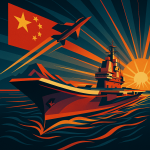Key Points
- The `Fujian` (Fujian 福建) marks China’s entry into the three-carrier era, significantly boosting its naval capabilities.
- The `Fujian` (Fujian 福建) is China’s first domestically designed and built CATOBAR carrier, featuring advanced electromagnetic catapults.
- With a displacement of over 80,000 tons, the `Fujian` (Fujian 福建) is the world’s first conventionally powered carrier with electromagnetic catapults.
- A three–carrier system provides wider reach, strategic depth, and ensures operational readiness through a rotational schedule (maintenance, standby, deployed).
- China’s rapid carrier development is fueled by comprehensive national strength, including economic power, world-class shipbuilding, skilled human capital, and independent innovation.

Get ready for a deep dive into a monumental shift in global naval power.
China’s Navy is leveling up, big time, with its third aircraft carrier, the `Fujian` (Fujian 福建), signaling the nation’s entry into the elite three-carrier era.
This isn’t just another ship; it’s a statement.
Meet the `Fujian` (Fujian 福建): China’s Tech-Forward Naval Behemoth
The `Fujian` (Fujian 福建) is a beast and a pioneer.
It’s China’s first-ever domestically designed and built catapult-assisted takeoff and arrested recovery (CATOBAR) carrier.
Think a flat, through-deck flight deck – super efficient for launching and landing aircraft.
And get this: it’s kitted out with cutting-edge electromagnetic catapults and arresting gear.
With a full displacement hitting over 80,000 tons, the `Fujian` (Fujian 福建) proudly stands as the world’s first conventionally powered aircraft carrier to rock electromagnetic catapult technology.
That’s a serious mic drop.
Key Milestones for the `Fujian` (Fujian 福建) (Hull Number 18):
- Launched: June 17, 2022.
- Mooring Trials: Underway as planned by September 23, 2022.
- First Sea Trial: Kicked off on May 1, 2024, running for 8 intense days.
- Systems Check: Power and electrical systems tested and met all expected goals during the first sea trial.
Currently, the `Fujian`’s (Fujian 福建) sea trials are chugging along smoothly, right on schedule.
This vessel is a critical component as China looks to significantly upgrade its naval capabilities.

Resume Captain
Your AI Career Toolkit:
- AI Resume Optimization
- Custom Cover Letters
- LinkedIn Profile Boost
- Interview Question Prep
- Salary Negotiation Agent

The “Three-Carrier Era”: What It Means for China’s Maritime Clout
So, three years after the `Fujian` (Fujian 福建) first made waves, its construction and sea trials are pushing forward full steam ahead.
What’s the big deal about the `Fujian` (Fujian 福建) and China hitting this three-carrier milestone?
How does it impact China’s strategy for safeguarding maritime rights and interests and ensuring maritime passage safety?
And could this new era spark disruptive innovations in how naval operations are run?
Military commentator `Wei Dongxu` (Wei Dongxu 魏东旭) breaks it down for us.
`Wei Dongxu` (Wei Dongxu 魏东xu) highlights that successfully establishing a three-carrier combat system is a massive W in China’s military equipment playbook.
He states, “It represents a comprehensive enhancement of defensive capabilities in the maritime domain and constitutes the most crucial maritime combat platforms for active and proactive defense.”
Here’s the strategic advantage of having three carriers:
- Wider Reach: Allows for simultaneous deployment of carrier forces in three major directions.
- Strategic Depth: The inherent maneuverability of carrier strike groups offers much broader security coverage.
- Always Ready – The Rotational Edge:
- One carrier could be undergoing maintenance.
- Another could be on standby, ready for rapid tasking.
- A third could already be deployed at sea, actively executing a mission.
This setup ensures that, in terms of aircraft carrier platform utilization, China “always has a reserve force and a ready backup.”
This is a significant leap in naval operational readiness and power projection.

The `Fujian` (Fujian 福建) Carrier: Constant Innovation and Overtaking Rivals
Looking ahead, how will these three aircraft carriers divvy up functional roles and combat missions?
And what kind of punch does this carrier strike group system pack in boosting the Chinese Navy’s overall combat capability?
`Wei Dongxu` (Wei Dongxu 魏东旭) offers more insights.
He explains the evolution:
The `Liaoning` (Liaoning 辽宁) carrier: This was an import, refitted and technically modified to serve as China’s first aircraft carrier.
Post-entry, it served as a crucial research and test platform, helping China learn the ropes of carrier ops at sea.
The `Shandong` (Shandong 山东) carrier: This one was independently developed and built, drawing lessons from the `Liaoning` (Liaoning 辽宁).
It signaled China’s newfound ability to independently produce aircraft carriers.
Then comes the `Fujian` (Fujian 福建), and its speed of innovation is turning heads globally.
China jumped directly from ski-jump carriers (like Liaoning and Shandong) to catapult carriers with the `Fujian` (Fujian 福建).
And not just any catapults – electromagnetic catapults (EMALS).
Currently, only two nations globally have this tech: the United States and China.
Pause for effect.
Even more intriguing, `Wei Dongxu` (Wei Dongxu 魏东旭) points out, “according to authoritative analysts, our electromagnetic catapult technology may be even more advanced than that of the United States.”
This is a classic case of leapfrogging in technological development.
Expect to see some new birds on the `Fujian`’s (Fujian 福建) deck too.
It won’t just be the familiar `J-15 Flying Shark` (Jian-15 Feisha 歼-15飞鲨).
Next-generation carrier-based aircraft are anticipated to integrate with this new carrier, forming an even stronger maritime defense combat system.
This integration hints at a future where China’s carrier air wings are more potent and versatile.

Find Top Talent on China's Leading Networks
- Post Across China's Job Sites from $299 / role, or
- Hire Our Recruiting Pros from $799 / role
- Qualified Candidate Bundles
- Lower Hiring Costs by 80%+
- Expert Team Since 2014
Your First Job Post

Building Big: How Comprehensive National Strength Fuels Naval Ambitions
From refitting the `Liaoning` (Liaoning 辽宁), to independently building the `Shandong` (Shandong 山东), and now to the comprehensive innovation of the `Fujian` (Fujian 福建) – this “China speed” is impressive.
What are the key tech breakthroughs behind this rapid development of China’s aircraft carriers?
`Wei Dongxu` (Wei Dongxu 魏东旭) sheds light on the foundational pillars.
He credits, “firstly, the improvement of comprehensive national strength.”
Here’s what underpins this naval surge:
- Economic Muscle: China’s booming economy provides “sufficient national defense funds to build large maritime combat platforms.”
- Shipbuilding Prowess: China boasts a world-class overall shipbuilding capacity, including massive dry docks perfect for carrier construction.
- Human Capital: A “very skilled team of engineers, and an experienced team of workers and technical personnel.”
- Systematic Support: China has a “systematic guarantee for building aircraft carriers, relevant talent, and sufficient funding support.”
- Innovation Culture: Continuous independent innovation at both design and technological levels.
- Comprehensive National Strength
- Economic Capability (Defense Funding)
- World-Class Shipbuilding Capacity
- Skilled Engineering and Technical Personnel
- Systematic Project Support
- Independent Innovation
Therefore, `Wei Dongxu` (Wei Dongxu 魏东旭) concludes, “our aircraft carriers are being built larger and more advanced, and their combat capabilities are undoubtedly escalating one after another.”
This isn’t just about building ships; it’s about building an entire ecosystem of technology, industry, and expertise.
The arrival of the `Fujian` (Fujian 福建) and the three-carrier era is a clear indicator of China’s long-term strategic vision and its rapidly advancing capabilities on the world stage, especially in asserting its maritime power.

ExpatInvest China
Grow Your RMB in China:
- Invest Your RMB Locally
- Buy & Sell Online in CN¥
- No Lock-In Periods
- English Service & Data
- Start with Only ¥1,000


![Nvidia's China Play: Modified H20 AI Chip Set for July Launch Amidst US Export Curbs [FreshFromChina]](https://freshfromchina.com/wp-content/uploads/2025/05/nvidias_china_play_modified_h20_ai_chip_set_for_july_launch_amidst_us_export_curbs.png____FreshFromChina-150x150.png)


